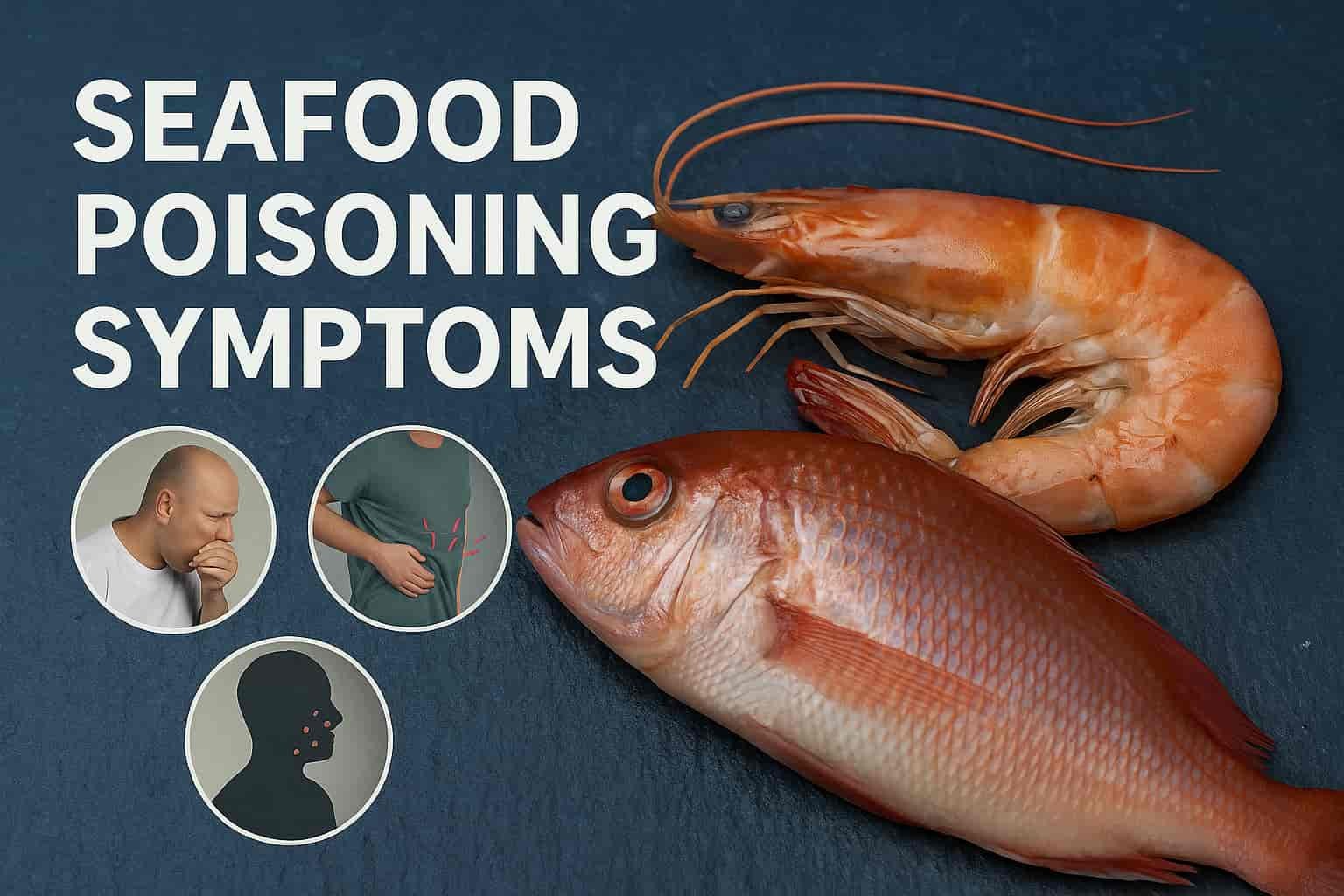Seafood is a popular dietary choice across the globe, celebrated for its rich flavors and nutritional benefits. However, improper handling, storage, or contamination can turn a healthy meal into a serious health threat. Seafood poisoning symptoms vary based on the toxins or pathogens present, and recognizing them promptly is critical for effective medical intervention. This guide provides a clear, structured overview of how these symptoms manifest across different body systems, helping you respond quickly and protect your health. Whether the issue arises from bacterial contamination or natural marine toxins, knowing what to watch for can make the difference between mild discomfort and life-threatening complications.
Contents
- 1 What Are the Most Common Symptoms of Seafood Poisoning?
- 2 Which Types of Seafood Poisoning Cause Neurological Symptoms?
- 3 What Gastrointestinal Symptoms Are Associated with Seafood Poisoning?
- 4 Which Seafood Toxins Cause Cardiovascular Symptoms?
- 5 What Are the Skin Reactions Related to Seafood Poisoning?
- 6 How Can You Differentiate Between Bacterial and Toxic Seafood Poisoning Symptoms?
- 7 When Should You Seek Immediate Medical Attention for Seafood Poisoning?
- 8 How Is Seafood Poisoning Diagnosed Based on Symptoms?
- 9 Are There Long-Term Health Complications After Seafood Poisoning?
What Are the Most Common Symptoms of Seafood Poisoning?
The most common symptoms of seafood poisoning include gastrointestinal distress, neurological disturbances, skin reactions, and cardiovascular irregularities. These symptoms typically appear within 30 minutes to 6 hours after consuming contaminated seafood.
- Gastrointestinal Symptoms: Nausea, vomiting, diarrhea, and abdominal cramps occur in over 85% of seafood poisoning cases.
- Neurological Symptoms: Headaches, dizziness, tingling sensations, and in severe cases, temporary paralysis.
- Skin Reactions: Rashes, hives, and intense itching affect about 30% of individuals experiencing allergic responses.
- Cardiovascular Symptoms: Irregular heartbeat and sudden blood pressure drops require immediate medical attention.
How Quickly Do Seafood Poisoning Symptoms Appear After Consumption?
Seafood poisoning symptoms typically appear between 30 minutes and 6 hours after eating contaminated seafood.
- Rapid onset (within 1 hour): Linked to toxins like saxitoxin and tetrodotoxin.
- Delayed onset (2–6 hours): Common with bacterial infections such as Vibrio vulnificus.
- Severe cases: Symptoms may develop within 15 minutes when consuming highly toxic species like pufferfish.
What Are the Early Warning Signs You Should Not Ignore?
Early warning signs that demand immediate medical attention include:
- Intense vomiting lasting more than 2 hours.
- Tingling or numbness in the lips, tongue, and extremities.
- Chest pain or irregular heartbeat.
- Difficulty breathing or swallowing.
Which Types of Seafood Poisoning Cause Neurological Symptoms?
Ciguatera and paralytic shellfish poisoning are the two primary types of seafood poisoning that cause neurological symptoms.
- Ciguatera Poisoning: Caused by eating reef fish contaminated with ciguatoxins. Over 50,000 cases are reported annually worldwide.
- Paralytic Shellfish Poisoning (PSP): Triggered by consuming shellfish contaminated with saxitoxin.
How Does Ciguatera Poisoning Affect the Nervous System?
Ciguatera poisoning disrupts normal nerve function by opening sodium channels, leading to abnormal nerve signaling.
- Symptoms appear within 6 hours after consumption.
- Temperature sensation reversal is a hallmark symptom.
- Muscle fatigue and unsteady gait may persist for weeks.
What Are the Neurological Effects of Saxitoxin in Shellfish Poisoning?
Saxitoxin blocks sodium channels in nerve cells, preventing normal nerve impulses and leading to paralysis.
- Symptoms start as early as 15 minutes after ingestion.
- Includes numbness in the face, muscle weakness, and difficulty speaking.
- Severe cases may involve respiratory paralysis.
What Gastrointestinal Symptoms Are Associated with Seafood Poisoning?
Gastrointestinal symptoms are the most common indicators, affecting over 85% of cases.
- Nausea and Vomiting: Present in 90% of cases.
- Diarrhea: Occurs in up to 80% of bacterial infections.
- Abdominal Cramps: Often severe and accompany diarrhea and vomiting.
How Severe Can Vomiting and Diarrhea Be During Seafood Poisoning?
Vomiting and diarrhea can cause dehydration within hours.
- Severe vomiting may occur more than 5 times per hour.
- Diarrhea may exceed 10 episodes per day.
- Hospitalization is required if dehydration becomes critical.
Can Seafood Poisoning Lead to Long-Term Digestive Issues?
Yes, certain types of seafood poisoning result in chronic digestive problems.
- Post-Infectious IBS: Affects 15% of patients.
- Chronic Malabsorption: Rare but affects nutrient absorption.
- Persistent Gut Dysbiosis: Can last for months or years.
Which Seafood Toxins Cause Cardiovascular Symptoms?
Seafood toxins like ciguatoxin and tetrodotoxin directly affect the cardiovascular system.
- Ciguatoxin: Found in large reef fish; causes tachycardia or bradycardia.
- Tetrodotoxin: Present in pufferfish; blocks sodium channels, leading to muscle paralysis and potential cardiac arrest.
How Do Seafood Toxins Influence Heart Rate and Blood Pressure?
Seafood toxins alter heart rate and blood pressure by disrupting electrical activity in cardiac muscle cells.
- Tachycardia: Heart rate exceeds 120 bpm.
- Bradycardia: Heart rate falls below 50 bpm.
- Hypotension: Systolic pressure drops below 90 mmHg.
What Are the Skin Reactions Related to Seafood Poisoning?
Skin reactions occur in about 30% of cases, primarily due to allergic responses or toxin exposure.
- Rashes and Hives: Develop within 30 minutes.
- Facial Swelling: Indicates severe allergic reactions.
- Flushing: Common in scombroid poisoning.
Can Seafood Poisoning Trigger Allergic Reactions Like Rashes or Hives?
Yes, seafood poisoning often triggers allergic skin reactions.
- Histamine Reactions: Cause hives and flushing in over 60% of cases.
- Shellfish Allergy: Triggers immediate skin reactions.
- Anaphylaxis: Requires emergency treatment.
How Can You Differentiate Between Bacterial and Toxic Seafood Poisoning Symptoms?
The key difference lies in symptom onset, patterns, and severity.
- Bacterial: Symptoms appear 6–48 hours post-consumption.
- Toxic: Symptoms appear within 30 minutes, often with neurological signs.
What Symptoms Are Unique to Vibrio Infections from Raw Shellfish?
Vibrio infections cause distinct symptoms including skin lesions and bloodstream infections.
- Severe Diarrhea: Present in 95% of cases.
- Fever and Chills: Indicate systemic infection.
- Necrotizing Fasciitis: Requires emergency surgery.
How Are Symptoms from Toxins Like Tetrodotoxin Different from Bacterial Infections?
Tetrodotoxin poisoning presents with rapid neurological paralysis rather than gastrointestinal symptoms.
- Rapid Onset: Symptoms begin within 15 to 45 minutes.
- Respiratory Failure: Can occur within 4 to 6 hours.
When Should You Seek Immediate Medical Attention for Seafood Poisoning?
Seek medical attention if the following symptoms occur:
- Difficulty breathing or swallowing.
- Severe chest pain or irregular heartbeat.
- Loss of consciousness.
- Continuous vomiting or diarrhea lasting over 4 hours.
Also, ensure you always consume fresh seafood to minimize these risks. Learn exactly how to tell if seafood has spoiled before preparing your meals.
What Are the Signs of Life-Threatening Seafood Poisoning Cases?
Life-threatening signs include respiratory distress and cardiovascular collapse.
- Respiratory Arrest: Requires immediate ventilation.
- Severe Hypotension: Systolic pressure below 80/50 mmHg.
- Full Body Paralysis: Requires ICU care.
How Is Seafood Poisoning Diagnosed Based on Symptoms?
Seafood poisoning is diagnosed through clinical evaluation and specific laboratory tests.
- Physical Examination: Focuses on neurological and cardiovascular signs.
- Laboratory Tests: Include blood cultures, toxin assays, and stool analysis.
- Toxin Detection: Specialized testing for marine toxins.
What Diagnostic Tests Help Confirm the Type of Seafood Poisoning?
Diagnostic tests vary by suspected toxin or pathogen.
- ELISA and HPLC: Detect marine toxins.
- PCR and Culture Tests: Identify bacterial pathogens.
- Neurological Assessments: Confirm nerve damage.
Are There Long-Term Health Complications After Seafood Poisoning?
Yes, some individuals experience long-term complications, especially from neurotoxic agents.
- Chronic Neurological Disorders: Symptoms may persist for months or years.
- Digestive System Disorders: Affect 15% of patients.
- Immune System Impairment: Increases infection susceptibility.
How Can Chronic Neurological or Digestive Issues Develop from Certain Seafood Toxins?
Chronic issues result from nerve cell and intestinal tissue damage caused by marine toxins.
- Nerve Damage: Leads to persistent sensory disturbances.
- Intestinal Damage: Causes chronic inflammation.
- Psychological Impact: Includes anxiety and food-related phobias.



